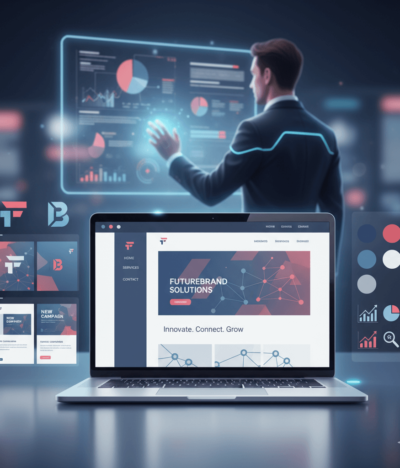The world of digital design has evolved faster than ever before. There was a time when websites were little more than digital business cards — static pages filled with text, a few images, and maybe a contact form. But that era is long gone.
Today, a website is the core of your business identity — a living, interactive ecosystem that communicates your brand story, converts visitors into customers, and fuels your marketing and advertising strategies.
In this fast-moving digital world, website design and web development have become art forms backed by technology and strategy. Modern businesses demand websites that are not only visually appealing but also fast, functional, and emotionally engaging.
Let’s take a journey through time — from the era of static HTML pages to today’s dynamic, interactive websites that drive branding, marketing, and digital success across industries.
1. The Era of Static Websites: Simplicity Over Strategy

When the internet first became accessible to the public, websites were purely informational. Developers hand-coded pages using simple HTML, often with limited visuals and no interactivity.
A typical business website in the late 1990s or early 2000s looked something like this:
-
A company logo at the top
-
Basic navigation bar
-
Text-heavy content about products or services
-
A “Contact Us” page with a plain email link
These sites worked as digital brochures — functional but lifeless. They didn’t reflect branding personality or user experience. There was no marketing integration, no analytics, and no way to measure engagement.
For a small business, having a website was a luxury — but not necessarily a tool for growth. There was little emphasis on SEO, conversions, or audience engagement.
However, as technology advanced and businesses began seeing the web’s potential, web design evolved from static displays to interactive storytelling.
2. The Rise of Dynamic Websites: Function Meets Experience
The early 2010s marked the turning point for the internet. Businesses started realizing that their websites could do more than just display information — they could generate leads, build credibility, and drive sales.
This led to the rise of dynamic websites, powered by technologies like PHP, JavaScript, and content management systems (CMS) such as WordPress, Drupal, and Joomla.
Dynamic websites allowed businesses to:
-
Update content easily through CMS dashboards
-
Integrate with marketing tools such as email automation and analytics
-
Deliver personalized experiences to different user segments
-
Add animations, galleries, and real-time features for engagement
Now, website design became less about code and more about communication. A website became a digital marketing engine, a platform that blended branding, advertising, and customer interaction.
Companies began working with professional website design agencies to ensure their sites looked modern, performed smoothly, and aligned with their brand message.
3. The Role of Web Development in Today’s Interactive World

Modern web development is the backbone of the digital experience. It combines creativity with technology to create websites that feel alive.
A skilled development team now focuses on:
-
Performance optimization: Faster load times and lightweight architecture.
-
Interactive animations: Motion graphics, parallax effects, and hover transitions.
-
Dynamic data-driven content: Websites that adapt to user preferences and behavior.
-
Seamless integration: Linking your website to CRM systems, social media, and advertising campaigns.
The boundaries between design, marketing, and technology have blurred. A well-developed website now acts as a hub — where your branding, advertising, and marketing strategies come together to deliver measurable impact.
4. Web Design in the Interactive Age: Trends That Define 2025

We are currently living in the interactive age of web design, where every pixel serves a purpose. Modern users expect more — they want intuitive navigation, lightning-fast loading speeds, and immersive experiences.
Here are some of the biggest website design trends defining 2025:
🔹 1. Immersive Storytelling Through Design
Websites are now designed to tell stories — using scroll-triggered animations, videos, and motion graphics. A great design captures attention, evokes emotion, and strengthens brand recall.
For example, a branding and advertising agency might use dynamic visuals and transitions to reflect creativity and innovation — reinforcing its expertise through design itself.
🔹 2. Personalization and AI Integration
Artificial Intelligence is redefining how websites interact with users. From chatbots offering real-time support to personalized product recommendations, AI-powered web development helps businesses deliver tailored experiences.
🔹 3. Minimalism with Purpose
Clean layouts, simple color palettes, and strong typography are making a comeback. This approach improves user experience and helps highlight branding elements like logos, slogans, and calls-to-action.
🔹 4. Micro-Interactions for Engagement
Subtle animations — like buttons that react when hovered over or images that shift as you scroll — may seem small, but they dramatically enhance the sense of interaction and responsiveness.
🔹 5. Speed and Mobile Optimization
In the world of SEO and digital marketing, speed is everything. Websites that load quickly perform better in search rankings and provide a smoother user experience across devices.
Each of these trends blends website design, web development, and marketing strategy into one cohesive digital experience.
5. Branding and Marketing Through Dynamic Design
The connection between web design and branding has never been stronger. Your website is not just a place to showcase products — it’s where users experience your brand story for the first time.
Here’s how dynamic design supports branding and marketing success:
🟢 Builds Emotional Connection
Your brand’s tone, color palette, and visuals evoke emotions. Interactive web design ensures visitors feel your brand rather than just see it.
🟢 Enhances Advertising ROI
When your website looks professional and aligns with your ad campaigns, your visitors are more likely to convert. A cohesive branding and advertising strategy ensures your online and offline efforts complement each other.
🟢 Increases User Retention
Engaging animations, easy navigation, and personalized recommendations encourage users to stay longer — reducing bounce rates and increasing conversions.
🟢 Drives Consistent Marketing Results
A strong website serves as the anchor for your digital marketing — connecting SEO, PPC, social media, and content marketing into one seamless journey.
Your web development strategy must therefore support your broader branding and advertising goals, not just your visual design.
6. From Brochure to Experience: The New Role of Websites

Businesses that treat their websites as passive brochures often struggle to generate impact. The modern approach is to view a website as a dynamic experience platform.
Here’s how forward-thinking brands use their websites today:
-
As a storytelling tool to communicate vision and values
-
As a sales engine that integrates with CRM systems and lead funnels
-
As a content hub for blogs, videos, and campaigns
-
As a marketing tool optimized for SEO and user intent
-
As a brand touchpoint consistent with visual identity and tone
This transformation has redefined web design and web development — pushing agencies and designers to think like strategists, not just artists.
7. How to Transition from Static to Dynamic: A Roadmap for Businesses

If your website still feels static or outdated, it’s time to evolve. Here’s how you can make the transition effectively:
-
Evaluate Your Current Website: Identify weaknesses — such as poor user experience, low loading speed, or outdated visuals.
-
Hire a Professional Web Design Agency: Collaborate with experts who understand design psychology, SEO, and branding.
-
Focus on Web Development Fundamentals: Ensure your website is fast, mobile-responsive, and technically optimized.
-
Integrate Branding and Marketing Goals: Align every design decision with your brand message and target audience.
-
Create Interactive Elements: Add animations, hover effects, dynamic menus, and storytelling visuals.
-
Measure and Optimize: Use analytics tools to track user behavior, conversion rates, and engagement.
By blending branding, advertising, and web development, your website can become a long-term marketing asset rather than just a digital presence.
8. The Future of Web Design: Experience Is Everything
As technology evolves, web design is becoming increasingly immersive. We’re moving toward:
-
AR/VR-based websites that simulate real-world experiences
-
Voice-interactive interfaces for accessibility
-
Hyper-personalized marketing content generated in real time
In this future, the most successful brands will be those that view their website as a dynamic ecosystem — where creativity meets strategy and design fuels business growth.
Conclusion
The journey from static websites to dynamic, interactive platforms has completely transformed how businesses engage with their audiences.
Today’s successful brands don’t just have websites — they have digital experiences powered by creative website design, strategic web development, and integrated branding and marketing.
Your website should not only represent who you are — it should inspire users, guide them, and convert them into loyal customers.
Whether you’re a startup looking for visibility or an established brand ready to modernize your digital identity, investing in modern web design, branding, and digital marketing is the most powerful step toward lasting growth.








